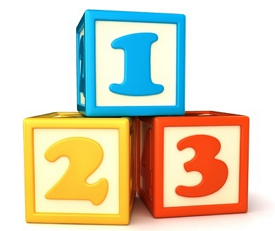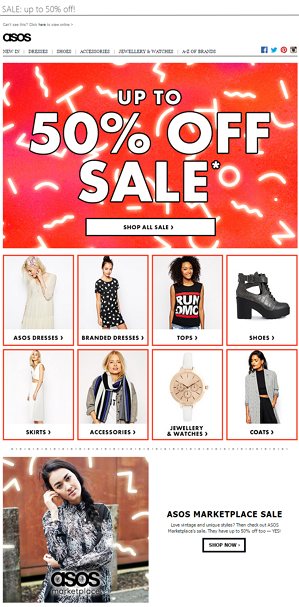 Your customers don’t experience single emails but rather the continuous flow of email content you send. If all your emails feel like the last one it’s time to take stock.
Your customers don’t experience single emails but rather the continuous flow of email content you send. If all your emails feel like the last one it’s time to take stock.
So rather than planning and conceiving email campaigns in isolation to each other, you need to stand back, look at the mix of content and types of email you’re sending over time.
A planned balance of marketing messages is needed. Typically the plan should cover 3 to 6 months. And the more marketing emails you send the more important it becomes to plan the right mix of emails.
This article explains 3 fundamental different types of email you should weave into your email content strategy. Whilst fashion emails are used to illustrate the principles in this article the concepts apply equally to all verticals.
The three types of email are; theme, discovery, conversion. Read on to understand what these are, why they are important and how to use them as building blocks in your email strategy.
Theme emails
Theme emails feature products that are all connected together by a common aspect. Very often that means products of a particular category. In fashion product category theme examples are party dresses, floral tops or jeans.
However, a theme doesn’t need to be based around a product category. It can be based on other things that connect related products. For fashion non product category examples are a particular designer label or 90’s style clothing.
But just because something connects products it doesn’t make it automatically a good theme. To pick a good theme consider how customers browse and buy. Whilst all garments to fit size 12 are connected it wouldn’t make a good theme, because that is not how people initially browse and select products.
 So the best themes are products that are connected together, such that if someone is interested in purchase of one of them then they’d also be interested in the others.
So the best themes are products that are connected together, such that if someone is interested in purchase of one of them then they’d also be interested in the others.
A big advantage of theme emails is that the subject line can provide clarity about the theme. This helps your customers identify the emails that will be most interesting to them, letting them easily self-select the content to read.
Example theme subject lines from ASOS include
- Neck it: polo necks high in style for AW14
- Nineties Normal – the smash-hit new style
- Need a new dress? Course you do
- Go nuts for Monki – the brand keeping Sweden swish
The headline, above the fold imagery and content is consistent with the subject line, continuing the momentum and getting them to continue reading. As they scan the email they find more content of the same type that initially hooked them, so it’s natural to keep reading, become more engaged with the content and increasing the likelihood of a click.
Theme emails work well for the shopper who already knows their mind. They work for the same reason shops don’t mix lots of different products onto one rail, but group like products together, because it makes it easier for customers to browse and buy.
Resist the temptation to include a mix of one of everything in your emails, hoping that you’ve something to appeal to everyone. By targeting everyone you target nobody.
The beauty of theme emails is that you can have something for everyone, but just not within one email. You ensure something for everyone by planning different themes over time. This week jeans, next week dresses and so on.
Discovery emails
A discovery email includes many unrelated products. The purpose is a bit like the digital equivalent of window shopping. The reader may have no immediate intent to purchase, but rather they are just browsing for ideas, inspiration and enjoyment. Just as with window shopping, a serendipitously discovered product means the browser can turn into a buyer too.

Discovery emails are the antithesis of targeting. Targeting is great except over targeting can mean you never discover wider interests of your customer and your customers never discover products they didn’t even know you stock.
Discovery emails help generate new and fresh demand. This is why discovery emails should be included in your email strategy, to illicit new behaviours.
Contrasting with theme emails, discovery email subject lines are less specific and play more on mystery and intrigue, subject line examples include:
- New styles you’ll love
- Our customer picked most popular
- What you’ll be wearing this season
The subject line on a discovery email is also an opportunity to create something less immediately sales driven for your lapsing and lapsed segments – as strong sales messages tend to turn off the lower engaged segment.
Conversion emails
 These are totally focused on moving the customer very quickly to your website and getting them to buy. They are the simplest in content of all three types, focused on buying messages.
These are totally focused on moving the customer very quickly to your website and getting them to buy. They are the simplest in content of all three types, focused on buying messages.
Large and bold offer messages with clear call to action of buy, normally with some type of discount and limited period to add in urgency to act.
These work in combination with previous theme and discovery emails. Customers who have been warmed up and engaged with the previous emails are taken through to conversion by the final push with incentive to act.
Whilst conversion emails are all about conversion, that is not to say theme and discovery emails aren’t selling too. They are all working together and performing roles to appeal to different customers and customers in different parts of the buying cycle.
Bringing it together
Using these building block emails plan out your campaigns over a period of time to create a balanced sequence of emails. Space out conversion emails with theme and discovery emails in-between.
Use a spreadsheet and map out the dates for each campaign, the type of email and a short summary of what it will include. For theme emails what the theme will be and for conversion the incentive to action you’ll use.
ASOS mix emails in about this ratio, 40% theme, 20% discovery and 40% conversion.
The sequence doesn’t need to be totally repetitive. Sometimes you might sandwich four or five emails between conversion emails, other times more. You might even send two or three conversion emails back to back for the big promotions.
It’s fine of course to also bring an element of conversion promotion into theme and discovery emails too. Don’t feel you can’t push for the sale just because it’s not a conversion focus email.
Go ahead now and jot down what themes would fit your business, and then sketch out your plan. Here are some potential themes for other verticals to help get you thinking:
- Home & DIY; Kitchens, Gardens, Energy Saving (insulation/timer switches), Security
- Holidays; Destinations, types of holiday
- Toys; Electronic, Activity, Traditional, Age range suitability.
